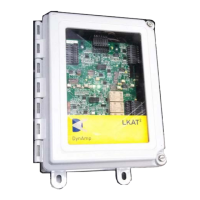Installation, Operation and Service Manual LKAT
2
Portable
© 2018 DynAmp, LLC Page 29
047312 A
6. MAINTENANCE & SPARE PARTS
6.1 PERIODIC MAINTENANCE
As is true with any electronic system, proper maintenance will tend to prolong the service
life. DynAmp, LLC recommends the following program be performed at the recommended
interval to prevent or detect damage to the LKAT
2
System and to ensure reliable
performance. Always use appropriate measures to correct any problems found. Following
the suggested maintenance schedule may assist in early diagnosis of problem(s) to
minimize repairs and down time.
If Main pc board LED (AD Status LED) is illuminated RED and / or the status relay
coil de-energizes, a fault condition may exist in the LKAT
2
electronics. When this
occurs, the system may require immediate attention. Refer to “Troubleshooting an
Accuracy Diagnostics Fault Indication”, in the “Theory of Operation” section of this
6.2 ANNUAL MAINTENANCE
Refer to the “Calibration” section of this manual for calibration intervals.
If possible, perform the steps described in section titled “System Checkout” in the
“Installation” section of this manual at least once per year to verify performance of the
LKAT
2
System. This may help to prevent or detect damage to the system and to ensure
reliable performance. Use appropriate measures to correct any problems found. If LKAT
2
System equipment is exposed to extreme temperatures, DynAmp, LLC recommends these
steps be performed during the hottest time of the year.
In addition, the following steps should be performed once each year as part of annual
maintenance:
1. Visually inspect Measuring Head and interconnection cable for evidence of severe
overheating, cracks, separation of bonded surfaces, or excessive corrosion. Record any
suspect conditions.
2. Inspect the Measuring Head mounting screws and adjust as needed.
3. Visually inspect Metering Unit for evidence of severe overheating, corrosion, or
condensation. Record any suspect conditions and take appropriate action.
4. Clean as necessary; remove any oil or grease with a mild detergent. Do not use
abrasives or strong chemical solvents as they may damage the cables or erase the silk-
screen markings from the Metering Unit.
5. Disconnect power to the system before servicing.
To avoid the risk of shock and electrocution, always disconnect all cable assemblies
before performing any cleaning on the Metering Unit.

